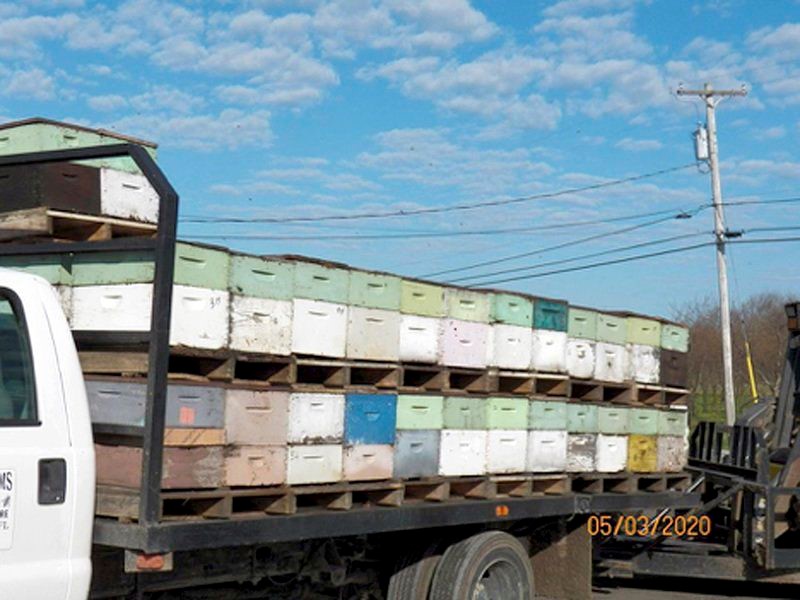Outstanding in My Field: The Buzz about Pollination
Margo Sue Bittner – Outstanding In My Field
The arrival of the truck with beehives at Bittner-Singer Orchards on May 3.
Our farm was the first stop for the UPS truck one day earlier this month. Now, that may not seem to be earth shattering news, but there was a specific reason we were first: Bumblebees.
Yes, every spring Bittner-Singer Orchards gets bumblebees delivered by UPS and the delivery driver feels better if he gets the boxes that are making the buzzing sounds off the truck ASAP.
And so starts our pollination season.
The last few years, we have done surveys of native pollinators that have been working in our orchards during bloom. We discovered a plethora of mining bees, sweat bees and wild bumblebees. So many, in fact, that we aren’t certain we need to add more bees to the mix each year. However, to feel confident that the fruit will be pollinated at the proper time, we do bring bees in.
The first kind of bee, as I mentioned above, are bumblebees. They arrive in hives that we set out in the orchard. We then open the trap door and let them do their thing. They fly in and out of the hive even on cool, cloudy and rainy days.
We also rent honeybee hives. These hives travel up and down the east coast depending on what is in season. If you are on a highway and see a flatbed truck piled with what look like old, weathered wood boxes and covered with a net, those could be honey bees.
Our bees come from Florida, stay in our cherry trees for a week, then move on to our apple orchards. When the apple bloom is done, they are transported to Maine to help pollinate the wild blueberries.
We set these hives in groups of four to eight around the orchards. If we do have to move them, we wait until early morning when it is cool. The bees are usually here for three weeks.
One of the biggest questions is why do we need pollinators? Some fruit trees can self-pollinate and set a crop. Other fruits, such as apples and sweet cherries, need cross pollination. Bringing in bees helps ensure that.
Another challenge with apples is that if they aren’t pollinated properly, the tree will get into an every other year pattern. This year we have a huge crop, next year we have nothing. We want to avoid that happening.
To end with a fun fact about bees on our farm: Between what we bring in, purchase and have found when we observe the local pollinators there are more than 1 million bees working in our orchards.
So bee observant when you beelieve you’ve encountered these buzzing workers!
Margo Sue Bittner, a.k.a. Aggie Culture, has been involved in Niagara County agriculture for 40 years. She’s had experience in dairy farming, fruit production and wine agri-tourism. Ask her any question about local agriculture and if she doesn’t know the answer herself, she knows who to get it from.
https://www.lockportjournal.com/news/lifestyles/outstanding-in-my-field-the-buzz-about-pollination/article_2e3f27c5-9a07-557b-91e1-a6ab27eb4e36.html
________________________________________________________________________________










